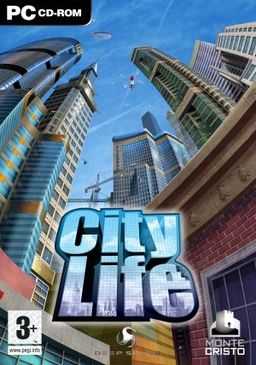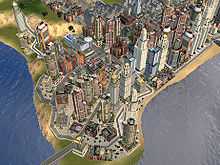City Life (video game)
| City Life | |
|---|---|
 | |
| Developer(s) | Monte Cristo |
| Publisher(s) | CDV Focus Home Interactive Deep Silver |
| Platform(s) | Windows, Nintendo DS |
| Release date(s) |
|
| Genre(s) | City building games |
| Mode(s) | Single player |
| Distribution | CD-ROM, Steam |
City Life is a city-building game that lets the player create a modern city. It is the first modern city-building game to allow the player to work in full 3D environment. The game is by French developer Monte Cristo. It is published in France by Focus, in the UK and Germany by Deep Silver and in North America by CDV. It was released in May 2006.
City Life allows players to zoom in and see every little bit of detail. The placement method allows buildings to be placed at an angle, as also seen in Sierra Games' Caesar IV.
More recently, the game has been criticized for lack of many detailed elements, such as weather, disasters, and more "in depth" user control.
Summary
City Life continues the very long tradition of city-building and construction and management games, that was originally started by Utopia from developer Don Daglow and Will Wright's SimCity series by allowing the player to customize their urban city's roads, buildings, finances, ordinances and much more. City Life utilizes a three dimensional game engine in displaying cities, and also includes the requirement to satisfy six different socioeconomic groups within the city, an essential part of gameplay. The six groups include the Elites, Suits, Radical Chics, Fringe, Blue collars and Have-Nots.
Classes

In game, the six classes are depicted in a circle. Clockwise from the top are Elites, Suits, Blue Collars, Have-Nots, Fringes, and Radical Chics. Each class can tolerate the two adjacent to it, but is hostile towards the three across the circle. Further, the income generated by businesses focusing on each class is indicated by its height on the circle, Have-Nots generating the least and Elites generating the most. Lastly, the left side of the circle favors education while the right side favors safety (e.g. police and fire department coverage). The higher classes are of course more demanding. When a city is founded, only Fringes, Have-Nots, and Blue Collars will settle there. The Suits must be attracted by having good conditions for the Blue Collars, the Radical Chics are attracted by good conditions for the Fringes, and the Elites are attracted by good conditions for both the Suits and the Radical Chics. Due to the literal class warfare, if classes that dislike each other live near each other, they will start riots and make complaints. Much of the gameplay focuses on arranging your city so that this will not occur.
Every business will employ a specific mix of classes; the earlier, less profitable buildings may employ only one class, e.g. six fringe, but later buildings require a mix of several classes to reach their full potential. Thus, a successful city must manage a population of each of the classes.

As their name implies, the Elites are the most powerful and wealthiest segment of the population. However, they are also the most demanding of the six, requiring quality services in sectors like education, safety, leisure, and environment. Elites are usually attracted to a city by "evolving" from either the Radical Chic or Suit groups. Most of their employment will derive from jobs in the private industry (i.e. private clinics and private colleges,) as well as jobs in large financial institutions. They are, by far, the most lucrative socialculture of the six.
The Radical Chics are ranked among the higher income groups and are as lucrative as the Suits. They are very close to the artistic and creative world and have liberal views and dispositions. Employment for Radical Chics derive from jobs in designing (i.e. clothing and interior spaces,) researching, and cosmetic surgery. Radical Chics get attracted to a city by "evolving" from Fringes. This group favors services in education and retail.
The Suits are a wealthy community whom conduct business transactions within industries. Suits are attracted to a city by "evolving" from Blue Collars. They demand quality services in safety and healthcare among others. Their employment will derive from jobs in financial advising, auditing, accounting, and stock trading.
The Fringes are artists who have low incomes(slightly lower than that of Blue Collars) and are usually fans of cultural activities. They also lean towards liberal views of the world. Fringes are naturally attracted to any city with available housing, though under certain circumstances, they will "evolve" from Have-Nots. They demand good retail services and adequate educational services. Employment for the Fringes derives primarily from clothing workshops, wood companies, and paranormal activities (i.e. wraith hunters and extraterrestrial landing sites.)
The Blue Collars work in the industries of the city and have revenues close to that of the Fringes (they are slightly more lucrative.) They represent the typical suburban family with traditional values. Blue Collars will usually be attracted to a city with available housing, but under certain circumstances will "evolve" from Have-Nots. They demand good services for healthcare and decent services for safety. Employment for Blue Collars is usually found in industries, private investigating, fishing companies, and oil derricks/platforms.
The Have-Not community is at the crossroads between the artistic and the industrial worlds. They are the lowest on the scale of power and wealth. Have-Nots do not demand any services at all. In fact, they are content with having nothing more than a house and a job. Unlike Fringes and Blue Collars, Have-Nots are not too easily attracted to a city. In order for them to appear, the player will usually have to create a district focusing primarily on Have-Not jobs and leisure activities. It is also possible to attract Have Nots by having Fringes and Blue Collars "devolve" into Have-Nots. This is achieved when Fringes and Blue Collars remain unemployed for a certain amount of time.
Economy
City Life has a simple economy. Each building has infrastructure costs which are paid by the city to the business, including fixed costs and costs which are related to the number of employees a building requires. Roads, bridges, parks and monuments also count as buildings in this way. Buildings also have indirect costs with regards the energy they consume and waste they produce. Buildings which represent businesses also generate income which is taxed and is paid back to the city. Therefore, the monthly budget for the city (i.e. for the player) is calculated by taking the taxed income and subtracting the infrastructure costs for each building. For example, the basic industrial building has $50 of fixed infrastructure costs and generates up to $100 in revenue tax per worker. When staffed with 3 workers the net profit for the city is thus $250 per month.
However, profits from business are not guaranteed at a fixed rate. For example, building a vegan restaurant in a city with a low population of Radical Chics will result in less than maximum income. Similarly, a casino won't turn maximum profit until there are Elites. In this way, the game forces the player to partially develop the richer communities in order to make their larger businesses viable.
Energy and waste in City Life are also considered a kind of income. Energy or waste management that the city provides for itself is cheaper than buying those services externally. Any surplus energy can be sold for profit, as can excess waste management. For example, a power station generates 5100 points of energy. If the city uses only 3100 energy, then the remaining 2000 energy will be sold and is counted as monthly profit. Incidentally this makes the power station one of the best initial industries for a city since it provides work for Blue Collar and profits are much larger than other industrial businesses.
Technical Issues
Technical support for the product is offered by the various publishers for their territory. It contains a number of documented work-around, patches and program updates.
Startup problems
Many users have problems getting the game to actually play. Sometimes before the game loads to 100%, the game crashes to the desktop which occurs if the video card does not support the pixel shaders required by City Life.[1] Users who lack the support for the required pixel shaders can use a program called 3D-Analyze to run City Life.[1] This problem can only be rectified by installing newer hardware that supports current pixel shaders. The game also has compatibility issues with Windows Media Center XP, and old video card drivers.[2] Some users have also experience compatibility issues with Windows Vista, though most Vista problems can be rectified by starting the game in Administrator Mode.
Expansions
World Edition
A City Life expansion pack, dubbed City Life: World Edition, was released on December 30, 2006 online and on January 15, 2007 in stores. World Edition features landmarks around the world, including the Eiffel Tower and the Sears Tower.
Additional content includes:
- Building Creation Tool
- 100 new buildings, bringing the total number of buildings to 300.
City Life Deluxe
On December 30, 2006, registered game users received an email advertisement for City Life Deluxe. It is available for purchase and download from the City Life website, though the site does not detail updates to World Edition within the expansion, if any.
2008 Edition
On August 30, 2007, Monte Cristo and Focus announced an upcoming second expansion pack for City Life entitled City Life 2008 Edition, saying the expansion would include "60 more buildings, bringing the total to 360, including famous structures such as St Pauls Cathedral, Royal Opera etc... New scenarios, 10 new maps, and an updated version of the editor allow you to import satellite maps, as well as import from applications such as World Machine, or GeoControl." The official release date for the expansion pack was November 10, 2007. On November 16, 2007, the release date was pushed back to November 23, 2007. The game was finally released effective on 15 February 2008. Also, Monte Cristo has confirmed in 2008, that they would make a City Life game for Nintendo DS.
DS
On August 7, 2009, a DS version was released in Europe.[3]
Reception
City Life 2008 received average reviews, with a Metacritic average score of 75. PC Gamer magazine in the UK said it was "no great shakes, but an awful lot better than SimCity Societies". IT Reviews said that "life in this particular city is rather humdrum, we're afraid, and owners of previous versions of the game will find new content rather thin on the pavement".[4] 1UP.com concluded that "the solid city-building engine still has legs - just nowhere to walk".[5]
See also
References
- ↑ 1.0 1.1 City Life Troubleshooting - A rather troubled game, but we have the fixes - Softpedia
- ↑ News: City Life Vista Compatibility Patch - GamersHell.com
- ↑ http://www.gamespot.com/ds/strategy/citylifeds/index.html
- ↑ http://www.itreviews.co.uk/games/g431.htm IT Reviews
- ↑ http://www.1up.com/do/reviewPage?cId=3168948&p=1 1UP.com
Other References